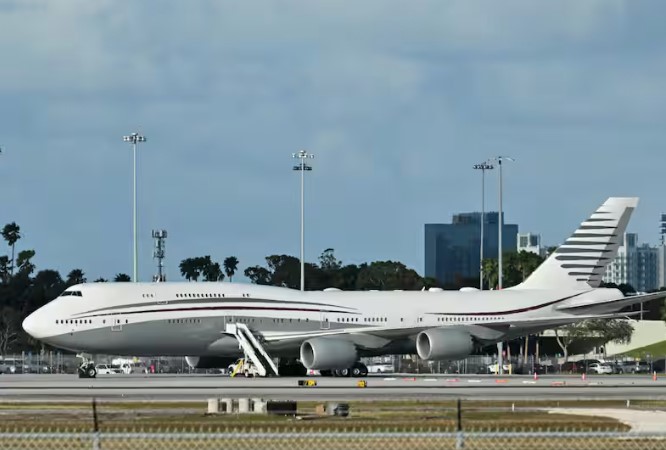The United States and Qatar are just days away from finalizing a highly debated agreement involving a Boeing 747-8 aircraft that could serve as a future version of Air Force One.
Qatar’s Boeing 747 “Gift” Awaits Final Approval
According to internal documents reviewed by The Washington Post, this aircraft is being described as an unconditional “donation” from Qatar’s Ministry of Defense to the U.S. Department of Defense (DoD).
The deal, first announced months ago, has faced a long delay despite early claims by the Pentagon that it was already complete. The aircraft in question, a Boeing 747-8, is among the most advanced commercial planes available. Qatar has agreed to donate this aircraft outright, without any cost to the United States.
The official memorandum of understanding (MoU), dated July 7, bears signatures from both U.S. Defense Secretary Pete Hegseth and Qatari Deputy Prime Minister and Defense Minister Soud bin Abulrahaman Al-Thani. However, a person familiar with the matter stated that the deal still requires final approval, as the Department of Defense recently requested small edits to the legal language used in the document.
Presidential Jet or Foreign Favor? Qatar’s $400 Million Flying Palace Stuns Washington
While spokespeople for both the White House and the Defense Department have not commented publicly, sources say this deal is on the verge of completion. Once finalized, the U.S. Air Force will begin modifying the aircraft to meet the strict standards needed for use as Air Force One — the official aircraft of the President of the United States. This process could take years and cost hundreds of millions of dollars.
Boeing 747 Donation Sparks Political Firestorm
This “gift” has stirred intense political debate since it was first revealed earlier this year. Critics from both major political parties have raised concerns over the legality and implications of accepting such a donation. Some lawmakers questioned whether this move complies with U.S. ethics rules and government procurement laws.
Democratic lawmakers have been especially critical. They pointed out that the aircraft may eventually be handed over to Trump’s presidential library — a plan confirmed by Defense Secretary Hegseth. That announcement sparked outrage among several members of Congress, who argue that such a donation could set a troubling precedent.
During a Senate Appropriations Committee hearing in June, Hegseth avoided giving clear answers when asked about the timeline and cost of renovating the aircraft. Sen. Jack Reed (D-Rhode Island), a top Democrat on the Senate Armed Services Committee, expressed frustration when Hegseth claimed that renovation details were “not for public consumption.” Reed responded, saying the Senate committee has the right to know where taxpayer money is going.
Qatar Warns Israel Over Reckless Buffer Zone Violation, Escalating Regional Tensions
Air Force Secretary Troy Meink testified in the same hearing that the aircraft renovation could cost under $400 million and would likely take less than a year. Democratic lawmakers quickly disputed these estimates, citing historical cost overruns and logistical delays in previous Air Force One projects.
Further fueling the controversy, the Pentagon plans to fund the aircraft conversion by reallocating defense money — especially from the Sentinel program, which aims to modernize America’s nuclear missile systems. Critics argue that pulling funds from an already delayed nuclear program for a presidential plane raises serious national security questions.
Legal Document Under Scrutiny
The signed memorandum of understanding includes specific language designed to distance the transaction from any appearance of misconduct. The document clearly states that the agreement must not be interpreted as involving bribery, undue influence, or any corrupt practice.
Originally, Qatar had requested that the agreement specify the aircraft would remain in the custody of the U.S. Air Force. The American side objected to the language during negotiations, so officials removed it, according to sources familiar with the matter.
Even with these legal precautions, questions still surround how the U.S. might use the aircraft in the long term. The MoU states that the U.S. must use the plane in accordance with its laws, but it doesn’t specify detailed restrictions.
Officials involved in the negotiation stressed that both countries have worked to keep the process fully within their respective legal systems. Qatar insisted on a government-to-government transaction, with its Ministry of Defense working directly with the U.S. Department of Defense. They asked political figures to take only minor roles in the talks.
Trump Unveils New F-55 Fighter Jet in Qatar, Twin-Engine Powerhouse Raises Global Eyebrows
Confusion intensified in May when the Pentagon announced the Secretary of Defense had accepted the aircraft. But sources now say officials are still finalizing the deal after spending two months editing legal language and holding behind-the-scenes talks.
Talks reportedly began in December under the Trump administration, following frustration over delays with previously ordered Boeing jets. The idea of a donated aircraft from Qatar soon took shape.
Though still pending, the deal is now nearing completion, marking one of the most unusual and politically sensitive aircraft donations in U.S. history.

